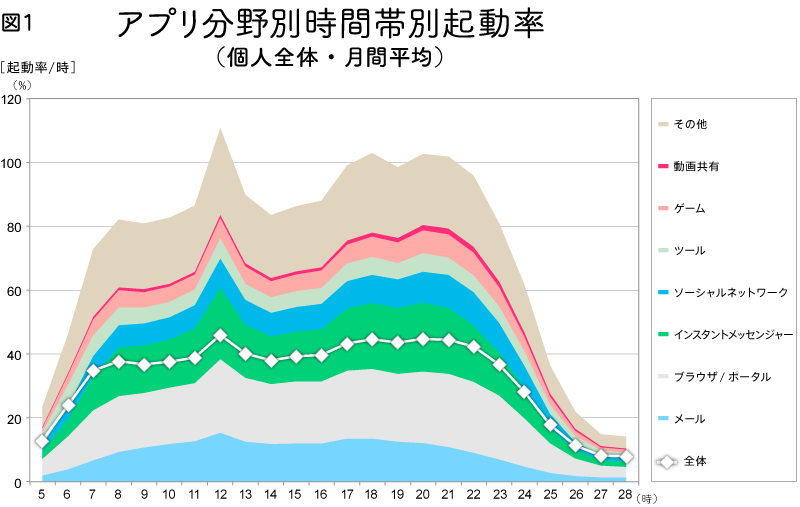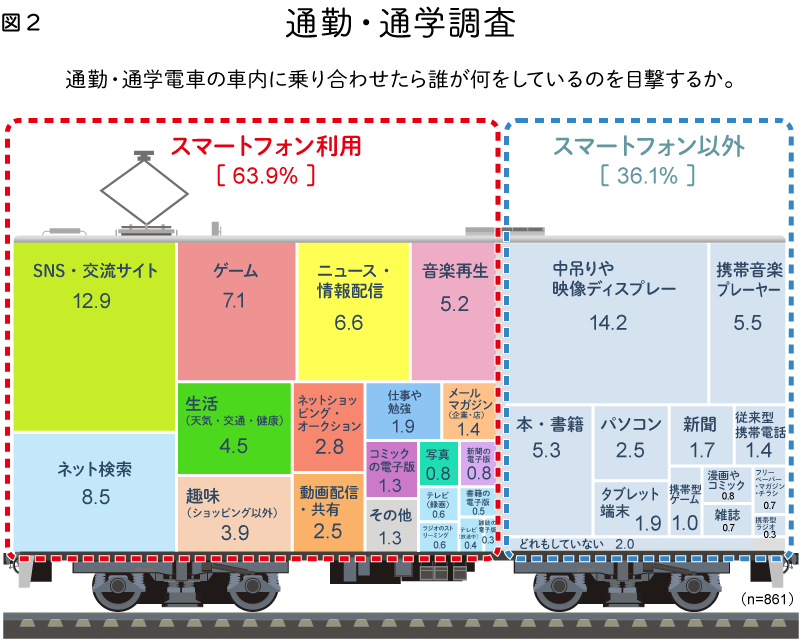
"Launch" refers to when an app, such as LINE, is opened to the front of the smartphone screen upon receiving a notification. We counted as "launches" only logs where the app was consciously opened, excluding background-running apps as much as possible.
The launch rate indicates the percentage of people who launched a smartphone app at least once during that one-hour period.
We compiled app usage log data from the devices of over 10,000 panel members for the entire month of January last year.
This data first reveals that about 40% of people launch an app at least once per hour throughout the day (since only logs from apps communicating via the internet are counted as "launches," the actual launch rate is likely even higher).
The peak occurs during lunch breaks, with another significant surge in the evening during the prime time hours of 7:00 PM to 10:00 PM, when television viewing is high.
The gray browser and the yellow-green instant messenger above it show consistent daily usage. The thicker light blue line above them represents social networks. Games show a distinct pattern of higher usage in the evening.
What activities would you witness if you boarded a commuter train?
Having grasped the daily biorhythm of app usage, the next point of interest is the actual usage patterns during commutes and school runs in Japan, a country with extensive train travel.
This was a survey conducted last December, not log-based. While log data shows which apps were launched and when, it's insufficient for understanding the TPO (time, place, occasion) of users—for example, where they were—and thus for gaining a comprehensive view of their lives.
In terms of catching a glimpse of a slice of life, survey-based research has its own merits. To show the reality of users captured in specific life scenes – at school? Eating in the cafeteria? With friends? Alone? – we'd like to share key insights from the results of a survey focusing on one such scene: commuting and going to school.
We surveyed people who commute by train at least once a week. We asked: "During your commute, how many days do you use your smartphone, for what purposes, and for how long?" We also asked how many days they engage with non-smartphone media like "advertisements," "video displays," or "books."
Some respondents do nothing or nap, so some answered they do none of these activities. This chart shows the weighted average, calculated by applying weights based on the number of commuting days and one-way commute time, then dividing back. It illustrates "What do you witness when riding the train?" with one train car set as 100 (sample size: 861).
The first thing noticeable when looking at the chart is that smartphones have become the major activity during commutes (63.9%). Time spent on activities other than smartphones accounts for 36%.
Breaking down smartphone usage further, social networking sites like SNS are the most common (12.9%), followed by searching (8.5%). This trend aligns with the previously mentioned log data.
Next are games (7.1%), followed by news and information consumption (6.6%). Music playback (5.2%) is noted with a caveat: respondents were asked to report only time spent consciously listening to music.
Viewing traditional 1seg mobile broadcasts is quite low (0.4%). While the decline in TV viewing among younger people is noted, this could lead to a situation where broadcast content struggles to reach a large audience. This connects to discussions about simultaneously streaming TV programs online to reach those who no longer watch traditional TV (this theme will be explored in more depth in future installments).





